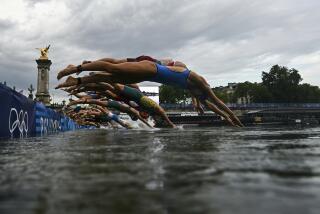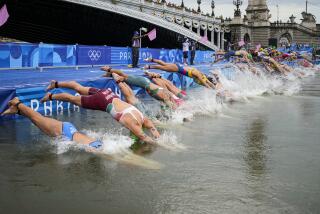The 10th Anniversary of the San Diego Triathlon a Tame Affair : Athletics: Plenty of history, stories behind the event.
- Share via
SOLANA BEACH — Carl Thomas worked in marketing for Speedo when he saw his first triathlon in the late 1970s.
Wow , he thought, what a great new market for swimwear .
So he contracted with Jim Curl, a sports promoter from Davis, to put on a series of five triathlons, the first of which was in Solana Beach in June, 1982.
People laughed at the thought of corraling a sport right out of the wild west and civilizing it. But Thomas and Curl did just that. On Sunday, the 10th running of the San Diego Bud Light Triathlon begins at 7 a.m. at the place where it all began.
If the 10th anniversary doesn’t sound significant, consider that triathlon became a recognized Olympic sport two months ago.
“I think we went from ground zero to Olympic recognition faster than any other sport in history,” said Murphy Reinschreiber, who acted as race director in 1982.
“All of a sudden, this guy from Davis (Curl) comes down and says he’s going to put on a triathlon,” Reinschreiber recalled. “And not only is he going to put on a triathlon, but he’s talking about having 600 participants. To that point, I don’t think more than 60 people had ever competed in one.”
When Curl first arrived in San Diego, he decided to go straight to the source and met with Scott Tinley.
“Tinley was already a God of triathlon by that time,” Curl said. “And he was telling me the problem with triathlons was that the run was too short, that to put on a really serious triathlon the run would have to be at least 15 kilometers.”
Curl agreed with Tinley and the first triathlon included a 15K run. Tinley had pulled a fast one.
“It wasn’t until two years later that we finally figured it out,” Curl said.
Tinley, who could barely keep his head above water, needed a long run to make up ground lost in the swim.
But Tinley didn’t win that first one. The honors went to Dave Scott. Tinley finished second, Scott Molina third and Mark Allen fourth.
Allen, however, might have finished higher if it weren’t for a mix-up in the transition area.
“Before we came along there were no rules in the transition area,” Curl said. “Guys were changing in their vans. Wives and friends waited there holding bikes and picnic baskets. Guys would eat half a sandwich before they went on the run.”
But one of Curl’s new rules was to close the transition area to everyone except athletes.
“Now we have this huge transition area with more than 600 bikes in it and suddenly the athletes had the added responsibility of remembering where their bikes were,” Reinschreiber said. “I remember Mark Allen coming out of the water.
“He’s in fifth or sixth place and he has racked his bike in the wrong place. He had a pair of Nike Odyssey shoes that he’s looking for and he finally spots this pair of Odysseys, but they were really a woman competitor’s shoes.
“So he’s hopping around the transition area trying to fit these size 7 shoes on his big feet and he can’t figure out what’s going on. I’ll never forget that sight of him hopping around trying to get these women’s shoes on his feet.”
There were other unforeseen glitches, including one that could have turned into a major fiasco.
In the early days, triathlon was a team sport in that athletes had pit crews to drive ahead and meet them at certain points of the run and see to their hydration needs.
But with 600 contestants, it was unfeasible to have 600 friends and family members driving along the course.
So organizers decided to provide community aid stations.
There was one problem.
“I’m driving along the course in front of Dave Scott, who’s leading the run at the time, and I get to a first aid station,” said Reinschreiber. “It’s set up OK, there were tables and jugs of water. But there were no volunteers and no cups. I had to get a coffee mug out of my car so Dave Scott could get some water. At that point all I could do was high-tail it back to the transition area and try to round up some volunteers and some cups. Luckily, Bill Gookin, who invented Gookin-Aid, was there. He had a mobile aid station all ready to go.”
Gookin takes it from here:
“I had about 5,000 cups in my van. They said they wouldn’t need any, but I brought some just in case. Plus I had some extra product and some barrels to mix it in. It ended up being a real contest in itself, trying to stay ahead of the runners.”
Added Reinschreiber, “Bill went all out and fixed all the aid stations. It could have been a disaster to put on a 15K run after a 2K swim and 40K bike ride without any aid, but I don’t think anyone other than the first 10 athletes noticed.”
All in all, Reinschreiber said, “We did a really decent job. No one drowned and no one got killed.”
More importantly, Reinschreiber, Curl and Thomas successfully brought law and order to the sport.
“Before we came in, it was illegal to hold a bike race on the road, so all triathlons were illegal,” Curl said. “What the triathletes would do would be to go tell the cops what they were going to do, but not ask for a permit because, by law, the police couldn’t grant a permit.”
Before Curl and Thomas, vice president and president of CAT (Carl A. Thomas) Enterprises, lawmakers saw no reason to cater to a cult of fitness lunatics.
Then the masses joined in.
“They brought it from cult status, something without rules, to a sport in the limelight,” Tinley said. “Critics complain and say the USTS and Bud Light homogenized the sport. But the truth of it is they stuck around and provided a solid base for up-and-coming triathletes as well as a huge opportunity for the masses to participate.”
While some recall the underground, pre-sponsor days fondly, Tinley has a different view. He was wary of the inherent danger of bike courses not being closed to traffic and of the danger of swimming in the ocean.
“I remember one triathlon at Torrey Pines,” he said. “It started with a 1 1/2-kilometer ocean swim. There was only one buoy, a Clorox bottle tied to a brick as an anchor. The lifeguard just said, ‘There it is. Go for it.’ I thought I was halfway to Catalina before I even got to the Clorox bottle.”
Things have changed. Swimmers now go out a little way, then turn up the coast before heading in--preferably by catching a wave and bodysurfing to shore. The swim has been shortened from two kilometers to 1.5, the bike race remains 40 kilometers and the run has been cut to 10. Also, more contestants now take part--1,800 are expected Sunday.
More to Read
Go beyond the scoreboard
Get the latest on L.A.'s teams in the daily Sports Report newsletter.
You may occasionally receive promotional content from the Los Angeles Times.










